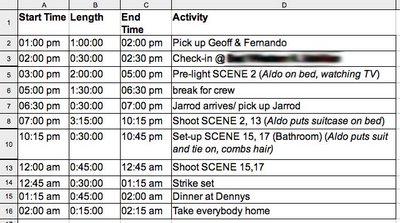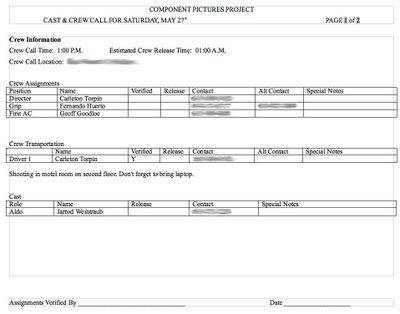Planning ahead
Planning is important when you want to make a movie. Sure, I've done movies that had almost no planning at all and they turned out well enough. But, when a producer is putting up money for a project, they want to see that you know what you are doing... and when you will be doing it. So I created a production schedule in Excel. (I was actually given the template for it by my Producer friend Barbara). It broke down like this:

This is the schedule for our shoot on the 27th. The Excel file made everything really easy. I simply input the "Start Time" and "Length" and it created the "End Time" for me. When I went to the next line, it auto-completed with the correct start time.
To make this kind of sheet on your own in Excel (or NeoOffice) just click the box you want to auto-calculate for you and tell it which boxes to add together. Ie: in the "End Time" box C2 I would type "=A2+B2". This tells the program to add cell A2 and B2 together to get C2. Skipping on down to the next line, for box A3 I would type "=C2". This will tell the program to bring down the results from the last "End Time" cell.
This all sounds a little confusing when it's not shown visually, but it is really easy to do once you have it formatted correctly.
Another thing that is essential to have on a production is the Cast and Crew Call Sheets. These are the sheets of paper that tell everybody on the production where and when to meet on the following day and who else will be there. I make one of these for each crew member and give them out the day before. Having everything in black and white ensures that there is no confusion on the day of. If the sheet says meet at 8 AM, it means meet at 8 AM. No excuses.

As you can see, there are several things to put on a call sheet. At the top, put the name of the project. (When I made this one, the movie still had no title so it just says "Component Pictures Project"). After that list the day the sheet is for. A few rows down you want to list your Crew Assignments. This can be 1 person (Director/Cameraman/Boom/Window Washer) or it can be a list of the 20 crew members needed. It just depends on the size of the production. Make sure to have at least 1 contact phone number for each person (2 is ideal). After that, I leave a few spaces for notes (if needed). Then I list Crew Transportation. On this day, that's just me and my Ford Exploder. On larger productions, this will likely be a Teamster, so get their dispatcher's number as well. After that comes Cast Assignments. This is a scene with just Aldo, so only Jarrod is listed. There is a column labeled "Release". This is to indicate whether or not we have a talent release form signed for him. If not, better get one before the end of the day! After all that junk, I usually have a section with Driving Directions to the shooting location along with the address and phone number.
That's just a small sampling of the kind of paperwork needed to get a production off to a good start. Obviously not every production needs this much, but it's always good to err on the side of caution. I hope not to "err" at all, but Murphy's Law is fond of moviemakers.

0 Comments:
Post a Comment
<< Home